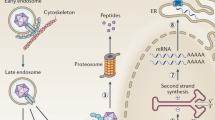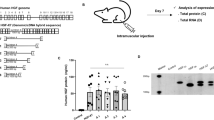Abstract
Gene delivery vectors derived from adeno-associated virus (AAV) have great potential as therapeutic agents. rAAV1 and rAAV6, efficiently target striated muscle, but the mechanisms that determine their tropism remain unclear. It is known that AAV6, but not AAV1, interacts with heparin-sulfate proteoglycans (HSPG). HSPGs are not primary receptors for AAV6, but heparin interactions may affect tissue tropism and transduction. To investigate these possibilities, we generated rAAV1 and rAAV6 capsids that do or do not bind heparin. We evaluated the transduction profile of these vectors in vivo across multiple routes of administration, and found that heparin-binding capability influences tissue transduction in striated muscle and neuronal tissues. Heparin-binding capsids transduce striated muscle more efficiently than non-binding capsids, via both intramuscular and intravenous injection. However, rAAV6 achieved greater muscle transduction than the heparin-binding rAAV1 variant, suggesting that there are additional factors that influence differences in transduction efficiency between AAV1 and AAV6. Interestingly, the opposite trend was found when vectors were delivered via intracranial injection. Non-binding vectors achieved robust and widespread gene expression, whereas transduction via heparin-binding serotypes was substantially reduced. These data indicate that heparin-binding capability is an important determinant of transduction that should be considered in the design of rAAV-mediated gene therapies.
This is a preview of subscription content, access via your institution
Access options
Subscribe to this journal
Receive 12 print issues and online access
$259.00 per year
only $21.58 per issue
Buy this article
- Purchase on Springer Link
- Instant access to full article PDF
Prices may be subject to local taxes which are calculated during checkout




Similar content being viewed by others
References
Schultz BR, Chamberlain JS . Recombinant adeno associated virus transduction and integration. Mol Ther 2008; 16: 1189–1199.
Sonntag F, Schmidt K, Kleinschmidt JA . A viral assembly factor promotes AAV2 capsid formation in the nucleolus. Proc Natl Acad Sci USA 2010; 107: 10220–10225.
Zincarelli C, Soltys S, Rengo G, Rabinowitz JE . Analysis of AAV serotypes 1-9 mediated gene expression and tropism in mice after systemic injection. Mol Ther 2008; 16: 1073–1080.
Rutledge EA, Halbert CL, Russell DW . Infectious clones and vectors derived from adeno-associated virus (AAV) serotypes other than AAV type 2. J Virol 1998; 72: 309–319.
Xiao W, Chirmule N, Berta SC, McCullough B, Gao G, Wilson JM . Gene therapy vectors based on adeno-associated virus type 1. J Virol 1999; 73: 3994–4003.
Gao G, Vandenberghe LH, Alvira MR, Lu Y, Calcedo R, Zhou X et al. Clades of Adeno-associated viruses are widely disseminated in human tissues. J Virol 2004; 78: 6381–6388.
Chao H, Liu Y, Rabinowitz J, Li C, Samulski RJ, Walsh CE . Several log increase in therapeutic transgene delivery by distinct adeno-associated viral serotype vectors. Mol Ther 2000; 2: 619–623.
Gregorevic P, Blankinship MJ, Allen JM, Crawford RW, Meuse L, Miller DG et al. Systemic delivery of genes to striated muscles using adeno-associated viral vectors. Nat Med 2004; 10: 828–834.
Wang Z, Zhu T, Qiao C, Zhou L, Wang B, Zhang J et al. Adeno-associated virus serotype 8 efficiently delivers genes to muscle and heart. Nat Biotechnol 2005; 23: 321–328.
Nakai H, Fuess S, Storm TA, Muramatsu S, Nara Y, Kay MA . Unrestricted hepatocyte transduction with adeno-associated virus serotype 8 vectors in mice. J Virol 2005; 79: 214–224.
Inagaki K, Fuess S, Storm TA, Gibson GA, McTiernan CF, Kay MA et al. Robust systemic transduction with AAV9 vectors in mice: efficient global cardiac gene transfer superior to that of AAV8. Mol Ther 2006; 14: 45–53.
Pacak CA, Mah CS, Thattaliyath BD, Conlon TJ, Lewis MA, Cloutier DE et al. Recombinant adeno-associated virus serotype 9 leads to preferential cardiac transduction in vivo. Circ Res 2006; 99: e3–e9.
Palomeque J, Chemaly ER, Colosi P, Wellman JA, Zhou S, Del Monte F et al. Efficiency of eight different AAV serotypes in transducing rat myocardium in vivo. Gene Therapy 2007; 14: 989–997.
Zincarelli C, Soltys S, Rengo G, Koch WJ, Rabinowitz JE . Comparative cardiac gene delivery of adeno-associated virus serotypes 1-9 reveals that AAV6 mediates the most efficient transduction in mouse heart. Clin Transl Sci 2011; 3: 81–89.
Burger C, Gorbatyuk OS, Velardo MJ, Peden CS, Williams P, Zolotukhin S et al. Recombinant AAV viral vectors pseudotyped with viral capsids from serotypes 1, 2, and 5 display differential efficiency and cell tropism after delivery to different regions of the central nervous system. Mol Ther 2004; 10: 302–317.
Taymans JM, Vandenberghe LH, Haute CV, Thiry I, Deroose CM, Mortelmans L et al. Comparative analysis of adeno-associated viral vector serotypes 1, 2, 5, 7, and 8 in mouse brain. Hum Gene Ther 2007; 18: 195–206.
Chamberlain J, Rando T . Duchenne Muscular Dystrophy: Advances in Therapeutics. Taylor and Francis: New York, 2006.
Halbert CL, Allen JM, Miller AD . Adeno-associated virus type 6 (AAV6) vectors mediate efficient transduction of airway epithelial cells in mouse lungs compared to that of AAV2 vectors. J Virol 2001; 75: 6615–6624.
Allen JA, Finn EF, Chamberlain JS . Novel characteristics of heparin binding by adeno-associated virus serotype 6. Mol Ther 2005; 11: S199.
Wu Z, Asokan A, Grieger JC, Govindasamy L, Agbandje-McKenna M, Samulski RJ . Single amino acid changes can influence titer, heparin binding, and tissue tropism in different adeno-associated virus serotypes. J Virol 2006; 80: 11393–11397.
Summerford C, Samulski RJ . Membrane-associated heparan sulfate proteoglycan is a receptor for adeno-associated virus type 2 virions. J Virol 1998; 72: 1438–1445.
Kern A, Schmidt K, Leder C, Muller OJ, Wobus CE, Bettinger K et al. Identification of a heparin-binding motif on adeno-associated virus type 2 capsids. J Virol 2003; 77: 11072–11081.
Hauck B, Chen L, Xiao W . Generation and characterization of chimeric recombinant AAV vectors. Mol Ther 2003; 7: 419–425.
Vandenberghe LH, Wang L, Somanathan S, Zhi Y, Figueredo J, Calcedo R et al. Heparin binding directs activation of T cells against adeno-associated virus serotype 2 capsid. Nat Med 2006; 12: 967–971.
WuDunn D, Spear PG . Initial interaction of herpes simplex virus with cells is binding to heparan sulfate. J Virol 1989; 63: 52–58.
Ohshiro Y, Murakami T, Matsuda K, Nishioka K, Yoshida K, Yamamoto N . Role of cell surface glycosaminoglycans of human T cells in human immunodeficiency virus type-1 (HIV-1) infection. Microbiol Immunol 1996; 40: 827–835.
Chen Y, Maguire T, Hileman RE, Fromm JR, Esko JD, Linhardt RJ et al. Dengue virus infectivity depends on envelope protein binding to target cell heparan sulfate. Nat Med 1997; 3: 866–871.
Compton T, Nowlin DM, Cooper NR . Initiation of human cytomegalovirus infection requires initial interaction with cell surface heparan sulfate. Virology 1993; 193: 834–841.
Levy HC, Bowman VD, Govindasamy L, McKenna R, Nash K, Warrington K et al. Heparin binding induces conformational changes in Adeno-associated virus serotype 2. J Struct Biol 2009; 165: 146–156.
O'Donnell J, Taylor KA, Chapman MS . Adeno-associated virus-2 and its primary cellular receptor—Cryo-EM structure of a heparin complex. Virology 2009; 385: 434–443.
Perabo L, Goldnau D, White K, Endell J, Boucas J, Humme S et al. Heparan sulfate proteoglycan binding properties of adeno-associated virus retargeting mutants and consequences for their in vivo tropism. J Virol 2006; 80: 7265–7269.
Nguyen JB, Sanchez-Pernaute R, Cunningham J, Bankiewicz KS . Convection-enhanced delivery of AAV-2 combined with heparin increases TK gene transfer in the rat brain. Neuroreport 2001; 12: 1961–1964.
Properzi F, Lin R, Kwok J, Naidu M, van Kuppevelt TH, Ten Dam GB et al. Heparan sulphate proteoglycans in glia and in the normal and injured CNS: expression of sulphotransferases and changes in sulphation. Eur J Neurosci 2008; 27: 593–604.
Lambaerts K, Wilcox-Adelman SA, Zimmermann P . The signaling mechanisms of syndecan heparan sulfate proteoglycans. Curr Opin Cell Biol 2009; 21: 662–669.
Johnson JS, Samulski RJ . Enhancement of adeno-associated virus infection by mobilizing capsids into and out of the nucleolus. J Virol 2009; 83: 2632–2644.
Stieger K, Schroeder J, Provost N, Mendes-Madeira A, Belbellaa B, Le Meur G et al. Detection of intact rAAV particles up to 6 years after successful gene transfer in the retina of dogs and primates. Mol Ther 2009; 17: 516–523.
Cox GA, Cole NM, Matsumura K, Phelps SF, Hauschka SD, Campbell KP et al. Overexpression of dystrophin in transgenic mdx mice eliminates dystrophic symptoms without toxicity. Nature 1993; 364: 725–729.
Grimm D, Kay MA, Kleinschmidt JA . Helper virus-free, optically controllable, and two-plasmid-based production of adeno-associated virus vectors of serotypes 1 to 6. Mol Ther 2003; 7: 839–850.
Blankinship MJ, Gregorevic P, Allen JM, Harper SQ, Harper H, Halbert CL et al. Efficient transduction of skeletal muscle using vectors based on adeno-associated virus serotype 6. Mol Ther 2004; 10: 671–678.
Acknowledgements
AA was supported by the Medical Scientist Training Program, and Achievement Rewards for College Scientists, as well as a National Research Service Award (NIH F30NS068005). This study was supported by NIH Grants AR40864, and AG33610 (to JSC).
Author information
Authors and Affiliations
Corresponding author
Ethics declarations
Competing interests
The authors declare no conflict of interest.
Additional information
Supplementary Information accompanies the paper on Gene Therapy website
Supplementary information
Rights and permissions
About this article
Cite this article
Arnett, A., Beutler, L., Quintana, A. et al. Heparin-binding correlates with increased efficiency of AAV1- and AAV6-mediated transduction of striated muscle, but negatively impacts CNS transduction. Gene Ther 20, 497–503 (2013). https://doi.org/10.1038/gt.2012.60
Received:
Revised:
Accepted:
Published:
Issue Date:
DOI: https://doi.org/10.1038/gt.2012.60
Keywords
This article is cited by
-
Systemic AAV6-synapsin-GFP administration results in lower liver biodistribution, compared to AAV1&2 and AAV9, with neuronal expression following ultrasound-mediated brain delivery
Scientific Reports (2021)
-
Rationally designed AAV2 and AAVrh8R capsids provide improved transduction in the retina and brain
Gene Therapy (2018)
-
Adeno-associated viral vectors do not efficiently target muscle satellite cells
Molecular Therapy - Methods & Clinical Development (2014)



